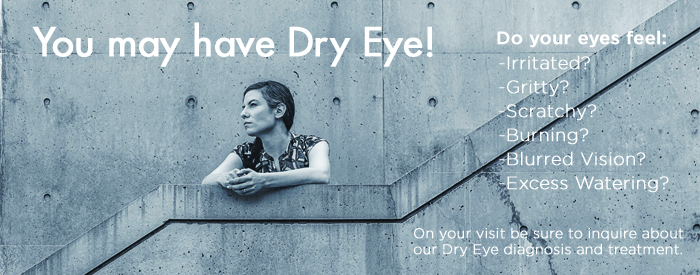Dry eyes can be uncomfortable and impact your daily performance and your ability to wear contact lenses.
Dry eye syndrome is a chronic condition that affects almost 50% of the adult population and millions of people around the world. It occurs when your eyes don’t produce enough tears, or your tear film quality is compromised.
Dry eye syndrome can result from an underlying eye condition, such as blepharitis or meibomian gland dysfunction, or can develop from certain environmental factors such as excessive screen time, poor air quality or living in a dry or windy climate.
Women can be prone to dry eyes, as symptoms are also common during periods of hormonal fluctuations, often worsening during menopause, menstruation and pregnancy.
Fortunately, there are many different types of dry eye treatments that can give you the relief you seek.
Here are the 5 most common signs of dry eye so you can inform your eye doctor if you are experiencing any of these symptoms:
1. Watery eyes
Yes, watery eyes can actually be a sign that your eyes are dry. Dry, irritated eyes stimulate an increase in tear production, which can overwhelm the natural tear drainage system in the eyes and impact the tear production-drainage cycle. This results in excess tears and watery eyes.
2. Stinging in your eyes
If your eyes feel like they are on fire, and the burning and stinging sensation makes contact lens wear impossible, this is a telltale sign that your eyes are dry and in desperate need of lubrication.
3. Blurry vision
Blurry vision that comes and goes and causes you to blink hard or frequently to improve your visual clarity, is another common sign of dry eye.
Note: Intermittent blurry vision can also be a sign of a serious eye condition, so consult with your eye doctor if you notice any form of blurry vision.
4. Eye discharge
Dry, crusty or stringy mucus in the corners of your eyes, especially upon wakening can be a sign of dry eye.
The tears are composed of water, oil and mucus. When tear production is stimulated by dry, irritated eyes, the tears often contain excess mucus which causes the unsightly discharge around your eyes.
Note: Yellow or green discharge from the eye can also be a symptom of pink eye (conjunctivitis), so it is important to consult with your eye doctor to rule out an eye infection.
5. Red eyes
Redness of the eyes is typically caused by eye irritation, and can be a symptom of many different eye conditions. But, if you are experiencing red eyes, along with any other dry eye symptoms, you are most likely suffering from dry eye.
However, to be sure, it is always best to consult with your eye doctor for a proper diagnosis.
SEE RELATED: The Link Between Dry Eyes and Accutane
If you are experiencing any of these 5 common signs of dry eye, schedule an eye exam with an eye doctor near you.
How are dry eyes treated?
Dry eyes are treated in a variety of ways, depending on the severity of your condition, as well as the underlying cause.
Mild symptoms are typically treated with over-the-counter artificial tears eye drops, gels or ointments that provide relief by lubricating your sore, irritated, dry eyes.
Your eye doctor may also recommend rinsing your eyelids with a gentle solution and using warm compresses to help loosen any discharge and improve the quality and quantity of your natural tears.
If your dry eyes are due to environmental factors, it’s important to make some lifestyle changes to reduce or eliminate your dry eye triggers. This may include wearing sunglasses to shield your eyes outdoors, reducing alcohol intake and limiting screen time. Adding omega-3 into your diet can also help to reduce dry eye symptoms and improve tear film quality and production.
If your dry eye symptoms are more severe, your eye doctor may recommend any of the following in-office dry eye treatments:
- Punctal plugs block the tear ducts to prevent tear drainage in order to preserve your natural tears.
- Blephasteam opens the meibomian glands to improve tear quality and reduce tear evaporation.
- Blephex facilitates increased tear production and reduces uncomfortable dry eye symptoms.
- LipiFlow thermal pulsation system opens the meibomian glands for improved natural production of lipids (oil), necessary to reduce tear evaporation.
- Intense pulsed light (IPL) reduces both inflammation and bacterial overgrowth — treating meibomian gland dysfunction, a common underlying cause of dry eye.
Along with these treatments, your eye doctor may prescribe medicated and/or steroidal eye drops for further relief, and recommend sleeping in moisture chamber goggles to help reduce tear evaporation and protect your eyes from allergens and irritants that can cause or worsen your symptoms.
LEARN MORE: Guide to Eye Conditions
If you are experiencing dry eye symptoms, contact an eye doctor near you to learn about treatment options.
Dry eye syndrome is a chronic condition that affects millions of people around the world.
Here are five of the most common signs of dry eye and their most effective treatments.










